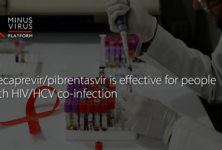If an HIV-positive patient’s viral load test results come back between 50 copies/mL and 200 copies/mL, consider retesting the same blood sample, Joseph Eron Jr., M.D., suggests. According to study results he presented at IDWeek 2016 on Oct. 28, the new test result may well show a viral load below 50 copies m/L, potentially altering the choices a clinician makes of how to approach that patient’s care.
The findings grow out of longstanding uncertainty about the clinical relevance of so-called viral load blips — when a viral load result is slightly above the test’s limit of detection, but is neither high enough nor repeated consistently enough over time to signal that virologic failure is occurring. In that scenario, Eron said, the typical approach is for a clinician to contact the patient (potentially increasing his or her anxiety), schedule a return visit for adherence counseling and retesting (costing time and money) and possibly order a resistance test, as well. With greater certainty regarding the meaning of a viral load blip, a clinician would be in a better position to efficiently treat the patient with minimal stress.
In an effort to increase that certainty, Eron, vice chief of the Division of Infectious Diseases at the University of North Carolina School of Medicine, and colleagues from Gilead Sciences and Covance conducted extensive re-evaluations of low-level viral load test results among 11 separate patient blood samples. Six of those samples involved HIV-1 RNA that, according to Eron, was serially diluted and divided into 50 tubes, then frozen and sent to central laboratories; the initial viral load results of those samples ranged from 4 to 142 copies/mL. Eron et al retested aliquots of all samples 50 times using an assay capable of yielding quantitative viral load results above 20 copies/mL.
The other five samples came from five patients with documented viral load histories who received detectable viral load results — four of whom appeared to potentially be experiencing viral load rebound (the four results ranged from 50 to 93 copies/mL), and one of whom had not yet achieved virologic suppression but was close (81 copies/mL). The same aliquotes of those samples were retested three to five times for each patient.
For each of the six serially diluted samples, Eron presented data on a plot chart showing the spread of the 50 retests for each sample. The results were “very tight data for a biological assay,” Eron said — and were within the test’s expected margin of error. Even so, the range of values for each sample was wide enough that a care provider might take a different clinical approach depending on which result was received. For instance, a sample that originally yielded a result of 36 copies/mL, below the limit of detection of commonly used assays, was found to have an average retest result of 61 copies/mL, with individual values ranging from less than 20 copies/mL to over 100 copies/mL. Two-thirds of the retest results in that case were over 50 copies/mL.
The lower the initial test result, the smaller the range of retest values, Eron et al discovered. While one sample’s initial result of 142 copies/mL ranged from roughly 70 to roughly 300 upon retesting, another sample’s initial result of 9 copies/mL never reached the 50 copies/mL threshold upon retesting.
When re-examining the five samples from the patients with documented viral load histories, similarly modest levels of variation were seen. However, given that the initial results were so close to the 50 copies/mL threshold to begin with, the retests were nonetheless significant at times. In one case, a patient went from an initial viral load of 57,000 copies/mL down to undetectable (below 50 copies/mL) within a few weeks of starting antiretroviral therapy. The patient remained undetectable until week 36, when a test yielded a result of 53 copies/mL.
Typically, Eron said, that marginally detectable result would trigger a phone call to the patient and repeat testing within the next few weeks. But by retesting the same blood sample three times, Eron et al found results of 23, 30 and 46 copies/mL — all below the typical threshold of detection. With that information in hand, such follow-up becomes clearly unnecessary.
Based on these findings, Eron proposed a new paradigm for addressing low-level viremic HIV viral load test results. In cases where a formerly suppressed patient has a new blood test result between 50 copies/mL and 200 copies/mL, Eron suggested, the clinician should order repeat testing of the same blood sample. If the repeat testing confirms that the patient’s viral load is above 50 copies/mL, then the typical cascade of follow-up can take place: Contact the patient; schedule a new office visit; draw a new blood sample for viral load testing; and collect a drug resistance sample, as well. But if the repeat testing finds viral load results below 50 copies/mL, the chapter can be considered closed: No new visit is required; no further blood work is needed; and the patient may not even need to be informed.
“Of course, this would require some sort of implementation,” Eron admitted — “if your lab would allow you to do this, or if central labs would [do] reflex testing [of] viral loads that were close to the limit of detection.” He also noted that banking of blood samples would be required for this paradigm to be successfully implemented.
By Myles Helfand


 ПОИСК ПО САЙТУ
ПОИСК ПО САЙТУ  поиск по ресурсному центру
поиск по ресурсному центру 



